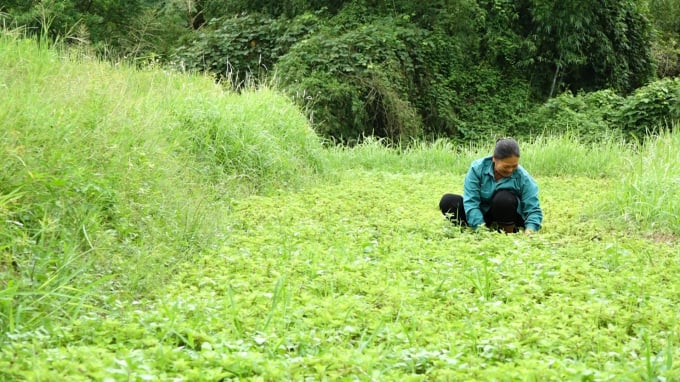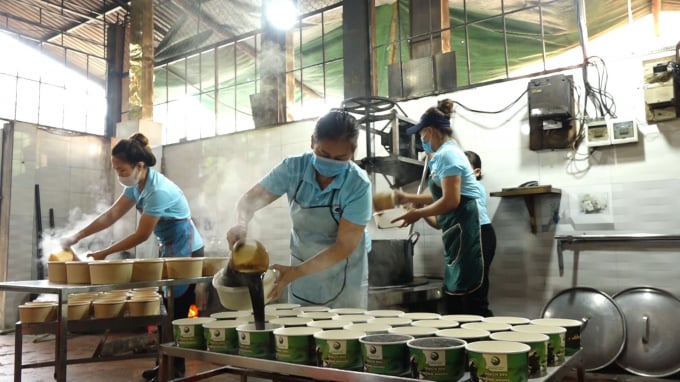June 16, 2025 | 08:17 GMT +7
June 16, 2025 | 08:17 GMT +7
Hotline: 0913.378.918
June 16, 2025 | 08:17 GMT +7
Hotline: 0913.378.918

Farmers in Trang Dinh district harvesting grass jelly. Photo: Nguyen Thanh.
Trang Dinh district grows the most grass jelly in the entire Lang Son province, with an annual production area of nearly 2,500 hectares.
Farmers in the district are currently harvesting the grass jelly from the spring crop. Farmers are excited that the grass jelly is in season for this year, so the price is stable, ranging from 20,000 to 35,000 VND for each kilogram of dried grass jelly.
Trang Dinh district has finished harvesting on an area of 1,000 hectares, which accounts for 60% of the total area. To improve the quality of grass jelly for export, the district organizes training courses on science and techniques of cultivation, nurture and harvest in the direction of organic production for farmers within the locale. As a result, the grass jelly products are ensured in terms of food safety, complying with the regulations on quarantine standards as well as meeting the requirements to export to the international market.
Ms. Be Thi Hieng from village 1, Tan Tien commune, Trang Dinh district, Lang Son province shared: “My family currently has around 1 acre of grass jelly grown organically. We plant the seeds during February, and can harvest in June. After being harvest from the fields, the grass jelly plants are cleaned, dried, tied in bundles, and placed at least 50cm above the ground to avoid dust, mold and dirt. For the last spring crop, my family harvested nearly 2 tons of grass jelly. Because we grow this plany organically, the quality of the jelly is very high, and the consumers love it".
Additionally, Trang Dinh district has developed a set of code for the grass jelly planting areas. This set of codes was built based on the program for the application of a standardized system in the management and certification of the fruit tree planting area codes for export (also known as OTAS). The district has more than 110 codes for grass jelly planting areas with a scale of 550 hectares.
Mr. Nguyen Van Kinh, Director of Hai Binh Agricultural Products Trading Company Limited in Trang Dinh district, Lang Son province said: “The official export of grass jelly products to China will bring great opportunities as well as raise the income level for farmers. The official export of grass jelly is considered a new step to improve Vietnam's export of agricultural products to China. When grass jelly products grain a foothold in the market, exporters like us are very relieved and excited. The market has opened, businesses and grass jelly farmers need to pay special attention so that the goods produced will be better, of higher quality, and meet the needs of the output market".

The finall grass jelly product is packaged in eco-friendly paper boxes. Photo: Trang Anh.
With the potential advantages of climate as well as suitable soil, the economic value of grass jelly has developed to be four times higher than that of rice. As a result, grass jelly is gradually becoming the main crop of the farmers in the districts of Binh Gia, Bac Son, Trang Dinh, Van Lang, Lang Son province.
The establishment of cooperative groups and teams has been promoted within grass jelly production areas to form concentrated areas qualified for planting area codes. So far, Lang Son province has 137 planting area codes granted by the Department of Plant Protection with a total area of 648.76 hectares There are four grass jelly packaging facilities qualified for packaging facility codes, meeting the requirements of Official Protocol and contributing to the expansion and promotion of grass jelly exports to the Chinese market.
Ms. Dinh Thi Thu, Deputy Director of Lang Son province Department of Agriculture and Rural Development said: "We have directed relevant units and District People's Committees with grass jelly production areas to strengthen training and guide people in the production process to ensure quality according to standards and regulations. We have also guided farmers on the nurturing of grass jelly to ensure high food quality, hygiene and safety. When harvesting grass jelly, farmers are advised to remove impurities, soil, rocks and animal hairs from the product. Additionally, we have established regulations on the implementation of planting area codes and compliance with the packaging requirements for grass jelly exports to China”
According to the Deputy Director of Lang Son Department of Agriculture and Rural Development, farmers have had a lot of changes in awareness regarding export products to the internatonal market. Namely, they have participated in the granting of safe planting and production area codes, handled plants in accordance with the technical process following export standards.
From the beginning of 2021 to July 2022, the Lang Son province Department of Agriculture and Rural Development and the Districts People's Committees organized 190 training courses for nearly 10,000 participants on the process of growing grass jelly, the contents uner the Official Protocol, and the basic standards regulations known as TCCS 774: 2020/BVTV by the Department of Plant Protection on the process of initiating and monitoring planting areas. On the other hand, the local governments have promoted technology advances in production and product traceability, strengthened the review and inspection of the granted planting area codes, formed production linkage chains to boost product value and manage product quality.
In 2021, the production output of grass jelly in Lang Son province reached 16,000 tons, which is an increase of 36% compared to that of 2020; the total export turnover was estimated at 7.5 million USD. or 2022, Lang Son province strives to achieve an export turnover of approximately 10 million USD for grass jelly.
In addition to the Chinese market, Vietnamese grass jelly is exported to many other countries including Thailand, Indonesia, Taiwan, and South Korea. In the immediate, Lang Son province will enhance trade promotion, advertising, connecting consumption and export of Lang Son grass jelly products to domestic and export markets.
Trang Dinh district currently supports facilities for processing canned instant grass jelly; or processed jelly powder to serve export. As a result, product quality is increasingly refined, and the range consumption markets are subequently expanded.
Translated by Nguyen Hai Long
/2025/06/12/3721-2-202745_83.jpg)
(VAN) TH made an impression at Seoul Food 2025 with its line of natural beverages, paving the way for Vietnamese food products to enter the South Korean market.

(VAN) Soc Trang's success in rice exports stems from a strategy of developing fragrant and specialty rice cultivation areas and standardizing production toward low-emission practices.
/2025/06/11/1311-5-120811_839.jpg)
(VAN) The pig farming industry is facing the challenge of comprehensive restructuring to meet requirements for quality, safety, traceability, and market expansion both domestically and for export.

(VAN) Vietnam considers participating in ALGROALBA in order to expand agricultural production, coordinate the assessment and effective exploitation potential land.
/2025/06/05/5314-1-184727_407.jpg)
(VAN) From seemingly worthless fish scales and skin, enzymes and lactic ferments can transform by-products into peptides, opening a sustainable, effective business direction and elevating Vietnamese seafood.

(VAN) TTC AgriS and IFC signed a strategic partnership to develop a sustainable agricultural value chain, aiming to achieve the Net Zero target by 2035.

(VAN) Seafood by-products are opening a new path, combining green growth and technological innovation to enhance the industry's value.